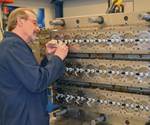Maintenance Matters: Cultivating Craftsmanship
Toolroom managers need to help repair technicians become skilled mold troubleshooters and craftsmen rather than tooling replacers and cleaners.
Maintenance training becomes increasingly necessary each time a boomer clocks out for good. Decades of repair experience and mold knowledge are gone in the flash of a retirement party, severely compromising ongoing mold maintenance. This is mainly because many companies do not document critical procedures accurately. On top of that, younger technicians coming into the craft must often learn how to work on molds by trial-and-error while older, more seasoned technicians pick up the slack of the departed boomer. To keep production rolling, the industry needs highly engaged repair technicians. The challenge for toolroom managers is helping repair technicians become skilled mold troubleshooters and craftsmen rather than tooling replacers and cleaners.
The first step is understanding what drives tradespeople. That is, someone who works with his or her head and hands and strives to achieve the master craftsman or journeyman skill level. Obvious motivations include great pay and benefits, or life-stage specific perks with flexible work hours. For mold maintenance technicians, getting a poorly performing mold back up and running or keeping a complex mold running efficiently and proficiently is deeply gratifying. These people do not need reminders to go out to a press and check on a difficult mold because they are already thinking about it all night.
The bottom line is that molders who want and need top-notch staff to maintain their molds need to offer higher-than-average wages while providing a clear path for growth and a sense of ownership of the process. So, how do employers keep the drive alive?
Creating the Job Description
Before any training takes place, the recruiter needs to develop a realistic job description. This requires not only an understanding of the typical maintenance and repair technician job, but also the varying personalities, company culture and management expectations. After performing hundreds of mold maintenance audits for an array of plastics manufacturers, I can safely say that the job of mold maintenance and repair is seldom fully understood by those crafting the descriptions.
Most mold repair technicians work with job descriptions that are vastly different from one another, even though the job itself is relatively the same from company to company. This is primarily due to the difference in perception of the required skills by the various companies and departments. This includes those directly affected by poorly running molds or high maintenance costs, those in production, processing or on the OEM side of the business, and those companies that offer both molding and moldmaking. For the latter group, repair techs are often cross-trained in toolmaking to maximize a smaller staff. Many believe toolmakers make better repair technicians, but I do not believe this is always true when it comes to mold repair.
In our experience, the majority of bonified toolmakers and mold builders dislike mold repair. Most are not wired to clean and repair molds. They want and need to build tools and components with metalworking equipment. Most repair technicians spend their day at a bench using hand tools and working their way through the eight stages of repair while relying on their knowledge of mold function. These include preventive maintenance preparation, disassembly, troubleshoot, corrective action, clean, assembly, final check and staging. This is important to note because the initial stages of repair technician training do not include learning how to run metalworking equipment, programming a CNC cutter path or developing a complicated setup at a grinder.
Training Musts
For companies to ensure that they are providing optimal maintenance and repair training, they must understand the job of mold maintenance as it applies to the types of molds and products that their company manufactures, and they must have real mold performance and shop efficiency metrics to gauge repair technician performance.
Being able to track and measure specific parameters and compare them to shop averages is invaluable—for example, number and type of molds worked on, issues corrected, molds with immediate issues after start-up, tooling and labor costs, etc. Here are a few mold repair job descriptions and metrics to get you started:
Mold Maintenance “C” (Apprentice level and typically offers three pay increases.)
- Possesses good mechanical aptitude and basic hand tool experience.
- Is able to aid in the safe moving, disassembly, cleaning and troubleshooting of molds and components in a methodical manner, and possesses the basic tools, physical skills and discipline to use specific, prescribed methods/procedures during this work. May be expected to handle simple in-press cleanings and lubrication of molds.
- Understands the importance of accurate, legible documentation and follows prescribed methods/procedures during work.
- Recognizes and enjoys the challenges of this trade, works well with others and demonstrates the willingness to learn about mold function and the desire to advance.
Mold Maintenance “B” (Intermediate level and offers three pay increases.)
At this stage, a manager should use maintenance metrics as an accurate indicator of skills. For example, an acceptable cost of overall repair efficiency (CORE) and results of overall repair proficiency (RORP) maintenance ratings can be set based on shop averages.
- Possesses the necessary mold function and maintenance knowledge and hand skills to safely, effectively and efficiently disassemble, clean, troubleshoot and assemble 40 to 75 percent of a company’s active molds with an efficiency rating of 75.
- Demonstrates safe and sound mechanical reasoning, desires to improve troubleshooting skills, reduce mold and part defects and increase root cause discoveries, and possesses knowledge of cold runner mold function.
- Uses precision tools to measure and calculate basic (static) tooling stack-ups to determine component preloads and clearances or to verify print dimensions.
- Is familiar with hot runner function and performs related maintenance and troubleshooting techniques. This person, for example, is familiar with probe tip cleaning, removal, reworking and basic electrical troubleshooting on probes, heaters, thermocouples, cables and manifolds.
- Demonstrates the ability to work safely and methodically through the eight stages of repair.
- Inputs clear, concise data into documentation system and mold maintenance manuals. Contributes to and uses a mold knowledge base.
- Proficiently uses and cares for hand tools, works methodically, employs organizational skill and contributes to shop cleanliness.
- Possesses basic skills to operate machine shop equipment like a surface grinder, drill press and lathe to perform intermediate-level tooling repairs like drilling, reaming and tapping holes, threading operations and dusting vents.
Mold Maintenance “A” (Advanced level and offers three pay increases.)
A performance metrics review is required to continue to judge maintenance and mold proficiency ratings. A high CORP and RORP rating can be set based on shop averages.
- Possesses the necessary knowledge, skills and tools to effectively and efficiently disassemble, clean, polish, troubleshoot/repair and assemble 75 to 100 percent of a company’s active molds.
- Performs advanced component repair (like welding, stoning, fitting or polishing) on issues like dings, scuffs and scratches, rework of worn or damaged tooling or plates; and fabrication of simple tooling, jigs and fixtures.
- Demonstrates that the company’s molds start and run productively without repeated pulls for missing or incorrectly installed tooling components or repeated mold/part defects.
- Performs complete dimensional mold tooling stack-out (static and dynamic) to determine tooling component preloads, clearances and fits, using any/all available prints.
- Determines “best” methods/procedures to institute mold/part defect probable causes, corrects and prevents certain actions of shop personnel and possesses excellent knowledge of how molds function.
- Can clean and repair hot runner molds, including manifold issues.
- Works in a steady, professional manner with little or no supervision.
- Mentors apprentice employees in proper mold maintenance techniques and methodology.
- Possesses an understanding of basic processing requirements for molds, such as proper venting, cooling, and polishing, and the configuring of nozzles, sprues, gates and runners.
- Understands critical mold function, plating applications and steel hardness requirements.
- Continuously seeks to improve knowledge base through ongoing studies, conferences, seminars or exhibitions focused on designing, building and maintaining molds.
Metrics allow managers to hold technicians accountable for the work that technicians perform. For example, instead of using a vague phrase like “you need to work smarter or harder and faster,” it is much more effective to use data to create tangible, achievable shop standards for acceptable, above average or excellent job performance.
Related Content
The Role of Social Media in Manufacturing
Charles Daniels CFO of Wepco Plastics shares insights on the role of social media in manufacturing, how to improve the “business” side of a small mold shop and continually developing culture.
Read MoreLeading Mold Manufacturers Share Best Practices for Improving Efficiency
Precise Tooling Solutions, X-Cell Tool and Mold, M&M Tool and Mold, Ameritech Die & Mold, and Cavalier Tool & Manufacturing, sit down for a fast-paced Q&A focused on strategies for improving efficiencies across their operations.
Read MoreWomen Impacting Moldmaking
Honoring female makers, innovators and leaders who are influencing our industry's future.
Read MoreICYMI, MMT Chats: 30 Under 30 Honoree, Plastics Engineering TA Teaches Value of Learning and Producing Not Perfection
MoldMaking Technology Editorial Director Christina Fuges brings on UMass Lowell Plastics Engineering Teaching Assistant Michael Shone as a guest for this MMT Chat to discuss moldmaking through the lens of academia. This episode is brought to you by ISCAR with New Ideas for Machining Intelligently.
Read MoreRead Next
Metrics for Assessing Maintenance Skills
Since the job description, qualifications, direction and goals may not be so clear, assessing a repair technician’s value can be confusing. Objective, tangible metrics are a must.
Read MoreHow to Use Strategic Planning Tools, Data to Manage the Human Side of Business
Q&A with Marion Wells, MMT EAB member and founder of Human Asset Management.
Read MoreReasons to Use Fiber Lasers for Mold Cleaning
Fiber lasers offer a simplicity, speed, control and portability, minimizing mold cleaning risks.
Read More









.jpg;maxWidth=300;quality=90)



.png;maxWidth=300;quality=90)















.jpg;maxWidth=970;quality=90)